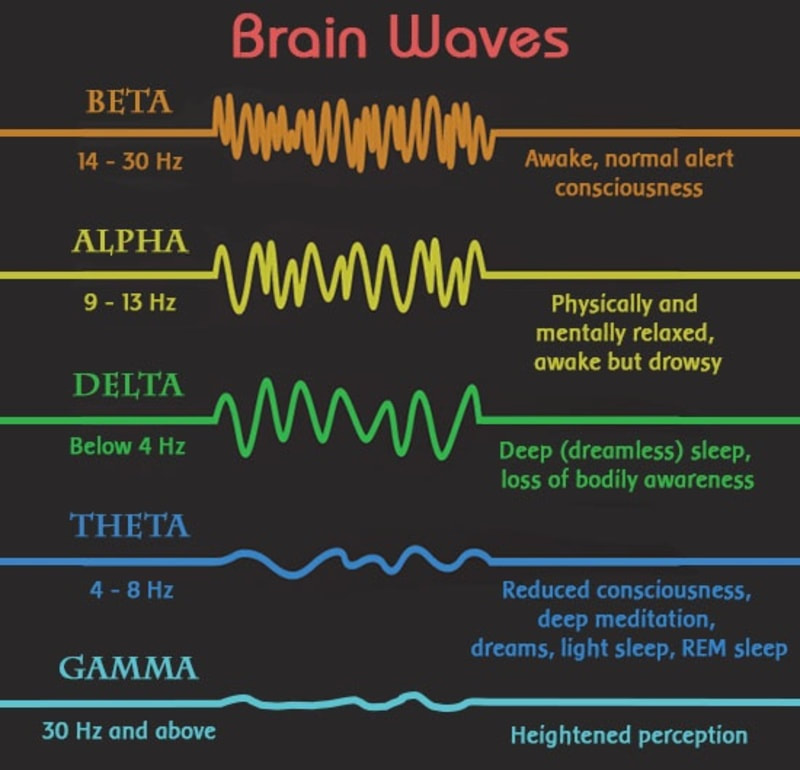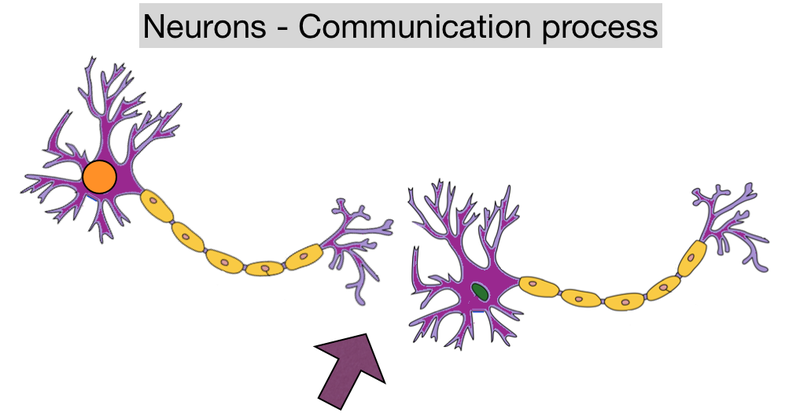The alarm sounds off at 6:30 am. You groggily turn it off.
Maybe you faintly recall a dream for a minute or two. You then quickly jump out of bed and hop in the shower to prepare yourself for a day of work, school, and/or tending to the family. From this point until you return back to a state of quietness and a lessening of physical and/or mental stimulus, you are likely to predominantly spend the majority of your day in the dominant brain wave state known as “Beta”. This state correlates with the frequency range between 12 and 30 Hz (some researchers will limit Beta to 25 Hz). Generally speaking when a person is in this state, they are experiencing varying degrees of being alert, engaged, and having focused mental activity. At the lower end (12 to 15 hz), one’s mood could be described as slightly brooding or idling (example: stuck in traffic, casually surfing the web). At the mid-range of Beta (16 to 22 hz) a person could be characterized as being strongly engaged (example: active, analytical problem solving). The upper range of Beta (23 to 30 hz) correlates with highly complex thought, the integration of new experiences, and excitement (example: creative problem solving).
When a person is awake but in a more relaxed state of being, their EEG wave is likely to be classified as “Alpha” which measures between 8 to 12 Hz. A behavioral characteristic of this state could be when you are day dreaming or in a non-engaged, relaxed state while watching television. This is generally the state that most people correlate with their recognizable and preferred state of relaxation. It’s not “overly” relaxed to the point of grogginess but the stress of one’s daily routines are markedly absent both physically and mentally.
The next EEG wave coincides with deep relaxation and possibly even light sleep. This is known as the “Theta” brain wave state and measures between 4 to 8 Hz. A behavioral characteristic of this state is normally when a person transitions from a relaxed state while laying in bed and eventually to the first stage of sleep. Theta is also recognized as a brain wave state induced during deep hypnosis, deep meditation, and sensory deprivation tank experiences.
The slowest type of EEG wave correlates with deep sleep known as “Delta” which measures between 0.5 to 4 Hz. Usually a person is in deep sleep when they are in this state. Experienced meditation practitioners have also been known to attain this EEG state during meditation.
(Note: Your brain is constantly emitting different frequencies simultaneously so when we refer to your specific brain wave state, we are referring to your dominant frequency.)
If these four brain waves (Beta, Alpha, Theta, & Delta) were the only brain wave frequencies humans generally experienced on a day to day basis, very basic “surface” logic would lead one to believe that the greater Hz levels would equate to potentially more precise and more accurate cognitive abilities. The logic would continue that as we slow down the dominant Hz frequency, our precise cognition would decrease and we would lose our abilities to “make sense” of the complex and intricate details. Anybody who has worked intensely on a project or task with any level of complexity can attest to the specific mental differences between pin-point focus/precision (example: a brain surgeon during surgery) compared to when one is on the couch watching their favorite movie… half paying attention, half day dreaming (example: a brain surgeon watching television). It would appear to make sense that at our peak focus and mental capabilities, we might hover in the 25 to 30Hz range during the day and in the evening we eventually slow down into light relaxation (10-12hz), deep relaxation (6-10hz), light sleep (4-6Hz), and subsequently deep sleep (0.5 to 4Hz).
If only things were so simple.
Gamma waves are classified as having a frequency of 30 Hz and above (some sources will cite anything above 25 Hz while others will cite only waves above 40 Hz). While analog electroencephalography (EEG) equipment was first introduced to the world nearly 100 years ago, the frequency reading for analog EEG was limited to 25 Hz and lesser. It wasn’t until the advent of digital electroencephalography (EEG) equipment in the 1970’s and subsequently ease of access to inexpensive microprocessors in the 1990’s that brain waves 25 Hz and above (Gamma) could be observed with greater consistency, accuracy and ease.

In 2009, a study was published in the journal Current Directions in Psychological Science titled “The Aha! Moment, The Cognitive Neuroscience of Insight”. This study was based on measuring neural correlates during sudden comprehension in problem solving moments which are deemed as an insight or an “Aha!” moment. EEG equipment and (fMRI) functional magnetic resonance imaging were utilized to study the frequency (Hz) and areas of the brain which became activated during these moments. The study concluded that insight solutions or “Aha!” moments are positively correlated with bursts of Gamma Waves (40 Hz).

Here is an excerpt from Brain World Magazine regarding the 2009 study:
“In the volunteers that experienced insight, Kounios and Beeman found a distinctive spark of high gamma activity that would spike one-third of a second before volunteers consciously arrived at an answer. Additionally, the flash of gamma waves stemmed from the brain’s right hemisphere—an area involved in handling associations and assembling parts of a problem. Gamma activity indicates a constellation of neurons binding together for the first time in the brain to create a new neural network pathway. This is the creation of a new idea. Immediately following that gamma spike, the new idea pops into our consciousness, which we identify as the Aha! Moment.
In addition, Kounios and Beeman noted a burst of slower, alpha-band activity over the right visual cortex—an area of the brain that controls our sight—occurring immediately prior to the burst of gamma waves. This unexpected finding suggests that the brain is quieting the neurons in that area to reduce the amount of distraction and visual interference taken in—similar to everyday circumstances, the way we close our eyes or look away when concentrating on a question—which then allows insight to pop into awareness.”
In 2008, a study was published in the Public Library of Science titled “Deconstructing Insight: EEG Correlates of Insightful Problem Solving” citing very similar results. The results of the study were as follows, “we found strong gamma band (40-48 Hz) responses at parieto-occipital regions which we interpreted as (i) an adjustment of selective attention (leading to a mental impasse or to a correct solution depending on the gamma band power level) and (ii) encoding and retrieval processes for the emergence of spontaneous new solutions.”

This is an extremely interesting finding being that it appears that there might be some basis for purposely quieting the mind and slowing the brain waves in order to consciously generate Gamma waves. If the conscious, active problem solvers in the study were able to generate mild Gamma wave spikes (40hz) that were immediately preceded by Alpha waves (8-12 Hz), there might be the potential for even greater Gamma wave spikes to manifest from inducing Theta (4-8 Hz) and even Delta (0.5-4 Hz) waves prior. In theory this would subsequently and simultaneously create more profound neural network development that leads to profound insights and possibly even greater, currently unassimilated cognitive abilities and even “supernormal” physical abilities.
Overall these studies indicate that the 40 Hz range offers us the bursts of significant insight that we can touch upon during complex problem solving. The question gets progressively more intriguing… what types of intuitions and/or experiences can people have at 50 Hz… 60 Hz… or 70 Hz and above? Digging in even further… since these Gamma waves take place in split-second bursts, what type of information might a person be capable of generating if Gamma waves were to be somehow sustained for prolonged periods?
The million dollar question on this site always seems to come back to… might this have any correlation with endogenously produced DMT?
In 2005, a study published in the Journal of Psychoactive Drugs reported “increases in global EEG coherence (total brain synchrony) in the 36-44 Hz and 50-64 Hz (Gamma Hz) frequency bands for both subjects”. This was a small study that involved two experienced participants who consumed the shamanic brew known as Ayahuasca. A 1998 study published in the journal Phytomedicine would publish similar results citing: “Post-ingestion, we observed increases in power in the 36-44 Hz frequency band (“40 Hz”)“. (Edit: A 2015 study published in the Public Library of Science and a 2001 study published in MAPS (Multidisciplinary Association for Psychedelic Studies) reiterate the Gamma wave formation from Ayahuasca ingestion.)
While this would be considered to be an externally administered form of dimethyltryptamine (DMT), it is still rather intriguing that Gamma waves appear to correlate with the experience.
Following the logic that a greater Hz measurement equates to potentially higher processing abilities and intuition it makes one wonder when DMT/Ayahuasca users describe a “realer than real” experience. While the term “hallucinogen” is utilized when discussing externally administered substances, it’s important to note that DMT is produced endogenously in humans as well as potentially all mammals. While it has yet to be officially verified, it appears as though DMT is likely produced during our sleepstages correlated with “dreams”.
In 2008, the Journal of Neuroscience published a paper outlining the relationship between Theta and Gamma coordination during REM sleep. Some notes from the paper are as follows (warning: most terms will be slightly incomprehensible without reading the entire paper and utilizing “google”):
“Theta and gamma synchrony (simultaneous occurrence) was significantly higher during REM sleep compared to active waking.”
“Whitened spectrogram of LFP recorded from the dentate molecular layer showing a typical period from REM sleep. Note the transient increases in the power and peak frequency of both theta and gamma oscillations. The gamma power increase in the whitened spectrum typically peaked around 100Hz, but the elevated power in these bursts often extended up to around 250Hz.”
“Compared to tonic REM periods (no eye movement), phasic REM (rapid eye movement, muscle twitches, respiratory variability) epochs showed increased theta and gamma power throughout most hippocampal layers. Comparing phasic versus tonic REM also showed increased theta coherence among CA1 layers and between the dentate and CA1, the latter possibly indicative of more coherent inputs from layers 2 and 3 of the entorhinal cortex to the dendrites of the dentate and CA1 respectively.”
“Gamma coherence increased among nearly all hippocampal regions during phasic REM compared to tonic REM (Fig. 5B,C), suggesting that while tonic REM is associated primarily with dentate/CA3 gamma synchrony, phasic epochs may provide short windows in which the dentate, CA3 and CA1 transiently synchronize.”
–
Whatever experiences that occur during “dream” states while sleeping are largely attributed to intelligible hallucinations. However, there are a few cases in which the information derived/interpreted during these “dreams” have led to important discoveries in science (ex. Einstein’s “Speed of Light”, Bohr’s “Atomic Model). Some of these significant findings are outlined by Tara MacIsaac of the Epoch Times in “5 Scientific Discoveries Made in Dreams” and “4 More Scientific Discoveries Made in Dreams”.
Does this equate to all dreams providing profound world changing information?
Not likely but it does lead us to ask the question whether the depth and profoundness of the insights taking place during waking and sleep states correlate with Gamma waves and potentially endogenous DMT synthesis. Based on the increased formation of new neural network pathways during these moments/states, it would outwardly appear that this “growth” would be a good thing especially if correlated with emotionally positive experiences. One must remain cognizant that varying amounts of DMT have produced a wide variation of effects. In Dr. Rick Strassman’s study the lowest dose administered (0.05mg/kg) provided no psychedelic effects while the highest dose (0.4mg/kg, 800% greater than the lowest) provided profound “hallucinatory” experiences. The fact that Gamma waves up to 250 Hz were registered in the 2008 REM sleep study would appear to provide some tangible framework as to the brain’s increased “processing muscle” during these “dream” states.Imagine what type of insights one might have in a conscious waking state of problem solving if they were able to generate 250 Hz!?!?
I digress… somewhat.
In any case, you’d be hard pressed to find any medical practitioner of any format that would declare deep sleep/REM sleep as being detrimental to the body and brain. In 2004, the American Psychological Association published some quotes from Dr. James B. Maas, a professor and former chairman of the psychology department at Cornell University who spoke at the Western Psychological Association’s 84th Annual Convention.
Quotes from Dr. Maas:
“Besides boosting alertness, sleep–particularly rapid eye movement (REM) sleep–is a way for the brain to store new information into long-term memory. The brain accomplishes this through a phenomenon that researchers have only recently come to understand: sleep spindles.”
“Sleep spindles–one- to two-second bursts of brain waves that rapidly wax and wane at strong frequencies, so-called for the spike image they form on an EEG reading–occur during REM sleep. The REM phase usually takes place toward the end of the night, between the sixth and eighth hours of sleep, when people are most likely to dream. The brain’s neural patterns during REM sleep resemble those of its awakened state.”
“During REM sleep, the brain busily replenishes neurotransmitters that organize neural networks essential for remembering, learning, performance and problem solving. Conversely, depriving the brain of sleep makes you clumsy, stupid and unhealthy.”
–
A study published in 2013 in the Journal of Neuroscience outlined in great detail the multiple regenerative properties of sleep especially during the REM stage. There are dozens if not hundreds of peer-reviewed papers as to the physiological benefits of deep, prolonged sleep.
What about people who claim to have “lucid dreams”?
The formal definition of a “lucid dream” is: “any dream during which the dreamer is aware that they are dreaming. During lucid dreaming, the dreamer may allegedly be able to exert some degree of control over the dream characters, narrative, and environment.”
In 2014, a study was published in the journal Nature Neuroscience titled “Induction of self awareness in dreams through frontal low current stimulation of gamma activity”. In this study the researchers were able to induce “lucid dreams” in sleeping participants via electrical stimulation of the brain. The conclusion of the study was as follows: “We found that current stimulation in the lower gamma band during REM sleep influences ongoing brain activity and induces self-reflective awareness in dreams. Other stimulation frequencies were not effective, suggesting that higher order consciousness is indeed related to synchronous oscillations around 25 and 40 Hz (Gamma waves).”
A 2009 study in the journal Sleep published a study based on deciphering the physiological correlates of lucid dreaming. The results were as follows: Results show lucid dreaming to have REM-like power in frequency bands Delta and Theta, and higher-than-REM activity in the Gamma band, the between-states-difference peaking around 40 Hz. Power in the 40 Hz band is strongest in the frontal and frontolateral region.
Thus far we have established “Aha! moments”, REM sleep dreaming, Ayahuasca treatments, natural “Lucid Dream” states, and externally induced “Lucid Dreaming” with this mysterious Gamma wave… what else might there be?
We’re guessing possibly a whole lot more… here is Part 2!
DMT Quest is a non-profit 501(c)3 dedicated to raising awareness and funds for endogenous DMT Research. This specific field of psychedelic research has been underfunded for many decades now. It’s time to take our understanding of human physiology, abilities, and perception to the next level. E-mail me at jchavez@dmtquest.org with any comments or questions. You can also follow us at Facebook, Instagram, or Twitter.
